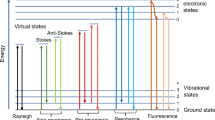Abstract
In magnetic resonance imaging, the gradient recalled echo sequence preserves information about spatial heterogeneities of magnetic field within a voxel, providing additional opportunity for classification of biological tissues. All the information, composed of physically meaningful parameters, like proton density, spin–spin relaxation time T 2, gradients of magnetic field and spin–spin relaxation, effective relaxation time \(T_{2}^{*}\), and many others, is encoded in the shape of a relaxation curve, which is more complicated than a pure monoexponent, traditionally observed in spin echo sequences. The previous work [A. Protopopov, Appl. Magn. Reason. 48, 255-274 (2017)], introduced the theory and basic algorithms for separation of those parameters. The present work further expands this theory to the case of spin–spin relaxation gradients, improves reliability of the algorithms, introduces physical explanation of the phenomenon previously known as “multiexponentiality”, and presents new validation of the algorithms on volunteers. The entire approach may be named the structural analysis of relaxation curves.







Similar content being viewed by others
References
E.L. Hahn, Phys. Rev. 80(4), 580–594 (1950)
N. Bloembergen, E.M. Purcell, R.V. Pound, Phys. Rev. 73(7), 679–712 (1948)
A. Protopopov, Appl. Magn. Reson. 48(3), 255–274 (2017)
L.R. Schad, G. Brix, I. Zuna, W. Harle, W.J. Lorenz, W. Semmler, J. Comput. Assist. Tomogr. 13(4), 577–587 (1989)
G.E. Hagberg, I. Indovina, J.N. Sanes, S. Posse, Magn. Reson. Med. 48, 877–882 (2002)
A. Hellerbach, V. Schuster, A. Jansen, J. Sommer, PLoS One 8(8), 1–8 (2013)
J.F. Schenck, Med. Phys. 23(6), 815–850 (1996)
J.R. Reichenbach, Th. Hacklander, T. Harth, M. Hofer, M. Rassek, U. Modder, Eur. Radiol. 7, 264–274 (1997)
H.Y. Carr, E.M. Purcell, Phys. Rev. 94(3), 630–638 (1954)
Acknowledgements
I am grateful to Prof. M. Bock, Prof. V. G. Kiselev, and Dr. J. Sedlachek for fruitful discussions, and to Prof. A. V. Melerzanov for support and encouragement.
Author information
Authors and Affiliations
Corresponding author
Rights and permissions
About this article
Cite this article
Protopopov, A.V. Structural Analysis of Relaxation Curves in MRI. Appl Magn Reson 48, 783–794 (2017). https://doi.org/10.1007/s00723-017-0890-0
Received:
Revised:
Published:
Issue Date:
DOI: https://doi.org/10.1007/s00723-017-0890-0




